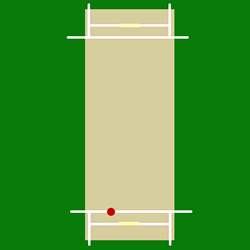Finger spin
| Part of a series on |
| Bowling techniques |
|---|
Finger spin is a type of bowling in the sport of cricket. It refers to the cricket technique and specific hand movements associated with imparting a particular direction of spin to the cricket ball. The other spinning technique, generally used to spin the ball in the opposite direction, is wrist spin. Although there are exceptions, finger spinners generally turn the ball less than wrist spinners. However, because the technique is simpler and easier to master, finger spinners tend to be more accurate.
The name finger spin is actually something of a misnomer, as the finger action is not a vital part of the mechanism for producing the characteristic spin on the ball. A finger spin delivery is released with the arm held in a fully supinated position, with the fingers on the outside of the ball (to the right for a right-handed bowler). If this supinated position is maintained through the release, the fingers will naturally cut down the side of the ball and produce a clockwise spin. The great English finger spinner Derek Underwood is famous for bowling finger spin in this manner. [1]
Additional spin many be put on the ball through two other means: the active supination of the arm from an initially pronated position just before the ball is released, and the flexion or extension of the wrist at the moment of release. Both techniques increase the effect of the cutting mechanism. The slower a spin bowler delivers the ball, the more actively he must attempt to impart spin onto it in order to maintain the same rate of revolution. [2]
Types of finger spinner

Although the cricket technique of finger spinner are the same for right and left handed bowlers, such bowlers are often discussed separately, as the direction in which the ball deviates as it bounces on the cricket pitch is different:
- Right handed finger spin is known as an off spin.
- Left handed finger spin is known as a left-arm orthodox spin.
The rest of this article assumes a right handed finger spinner bowling to a right-handed batsman.
Grip
A finger spinner grips the ball with the top knuckles of the index and middle fingers firmly gripping across the seam. The thumb is held clear of the ball.
Process
The stock ball for a right-handed finger spinner has a clockwise component of spin as well as a component of top spin. The stock ball for a left-handed finger spinner rotates the anticlockwise as seen by the bowler. For some finger spinners the index and middle fingers do a lot of work, snapping, to impart spin on the ball. At the other end of the spectrum there are finger spinners who rely much more on the wrist action. Either way, the wrist position at the point of release determines how the ball spins.
| Wrist position | Delivery | Intended outcome |
|---|---|---|
| Palm of hand facing batsman | Traditional off spinner. Side spinner. | Drifts away from batsman. Turns from off to leg side of the pitch. |
| Side of hand pointed to leg slip | Stock or attacking ball - part top spin, part side spin | Some turn, some dip or bounce and some drift. |
| Side of hand pointed to batsman | Top spinner | Dip - bounces high or lower in length. |
| Back of hand facing batsman | Doosra | Spining from leg to off the pitch |
| Back of hand facing the ground | Under cutter | Drift |
Variations
Off-spin
Traditionally, finger spinners bowled with an emphasis on side spin. With the advent of covered and better batting pitches the focus changed to bowling with a component of top spin. The top spin provides loop which makes it harder for the batsman to make an early judgement of the length of the delivery. The ball tends to be released with a slightly upward trajectory which raises the ball above the batsman's eye line. The topspin on the ball then causes the ball to dip earlier and bounce higher.
The side spin component of the delivery causes it to drift, courtesy of Bernoulli's principle. For a stock, side spin or under cutter this causes the ball to drift away from the batsman. The combination of drift, loop and spin combine to provide the finger spinner's attacking ability.
Doosra
Topspinner
Undercutter
Backspinner, Arm-ball and Teesra
A variation bowled by finger spinners is the arm ball or backspinner, currently being rebranded the teesra This ball is usually bowled slightly quicker than the orthodox off-spin delivery, with the fingers rolling down the back of the ball at release instead of down the side. The backspin makes the flight of the ball hard to judge, and may make the ball keep low. If the ball is gripped along the seam, the ball may swing in the air away from the batsmen. If the ball is gripped across the seam the ball will not swing, but the change in spin will be harder to detect. This delivery is analogous to the wristspinner's slider.
Coaching
Other key elements of the process of finger spin are:
- Foot alignment - a line drawn through the back and front feet should line up with where the ball is intended to the cricket pitch. Typically the back foot is nearly side on and the front foot between side on and pointing to the target. This aligns the body to deliver the ball to the target.
- Releasing the ball with the weight over the front foot. This drives the bowlers momentum towards the target. It also lets the bowler release the ball from maximum height.
- A vertical shoulder rotation that completes, for a right-handed bowler, with the right shoulder pointing at the target.
